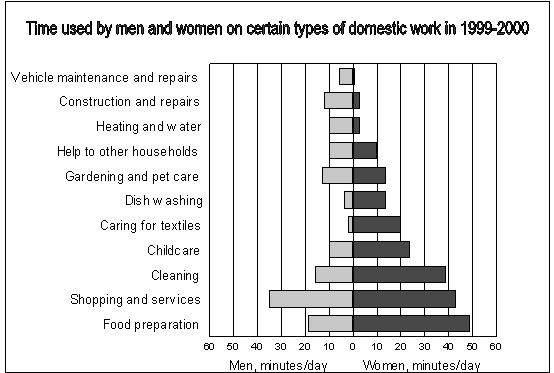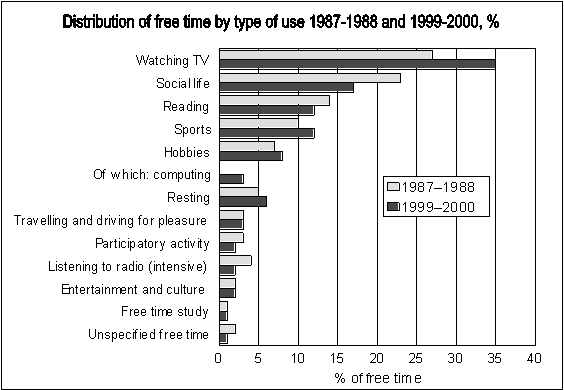13 December 2001
Inquiries: Ms Iiris Niemi +358 9 1734 3233, Mr Hannu
Pääkkönen +358 9 1734 3229
Director in charge: Mr Jussi Simpura
Division of work between the genders is evening out
Less gainful work is done in Finland today than at the end of the 1980s. The reasons for this are the ageing of the population and a fall in the number of employed persons. The average annual working time of those employed has remained unchanged but working days have grown longer and days of leave from work have increased. Men spend distinctly more time on gainful employment than women do. However, the difference between the genders has narrowed in this respect, as men's average annual working time has decreased while women's has increased. Differences in the working hours of various employee groups have also evened out. This is indicated by Statistics Finland's Time Use Survey for which data were collected in 1999 - 2000. Altogether 5,300 persons kept detailed diaries of their time use for the Survey.

The time used on domestic work increased slightly in the 1990s. The difference between the genders in the amount of time used on domestic work narrowed slightly as men participated in it more than before. Nevertheless, women still do good 60 per cent of all domestic work. The split into "women's" and "men's" domestic jobs grew less obvious, for men participate increasingly in cooking and cleaning and women do more home maintenance than before.
Television's share of free time has grown
Free time increased by one hour in the 1990s. Today, the Finns have 46 free hours per week, on average, at their disposal for leisure activities. Men have three hours more than women do. Slightly more of the free time is spent at home and slightly less of it is spent socialising than ten or so years ago. An increasing proportion - up to good one-third these days - of the free time is spent watching television. Men watch television more than women do.

Computers have not revolutionised free time at the whole population level. Nevertheless, young people spend one-tenth of their leisure time at the computer.
Time spent on exercise and outdoor activities increased in the 1990s, especially among those aged over 45. Although women increased the time they spend on physical exercise more than men did, they still use less time on it than men do. Men in Finland use 51 minutes and women 39 minutes per day on physical exercise.
The rhythm of daily life has altered in Finland insomuch that working days start slightly later than they used to. Consequently, people also go to bed at night and get up in the morning later than before.
Sunday has strengthened its position as the day of rest, when people sleep late and go out jogging or walking later than before. More time than before is spent watching television on Sundays. Saturday is still the actual day for doing domestic jobs, although they are also increasingly done on Sundays these days.
Source: Ajankäytön muutokset 1990-luvulla (Changes in Time Use in the 1990s). Culture and the Media 2001:6. Statistics Finland. Forthcoming in English.
